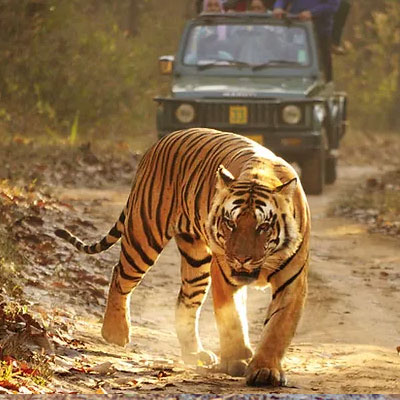Jeep safaris in Jim Corbett National Park prioritize safety for visitors and the wildlife within the park. Here are the safety measures and guidelines that are typically in place during a jeep safari:
1. Trained Guides:
- All jeep safaris are accompanied by trained and experienced guides who are well-versed in the park’s wildlife, safety procedures, and emergency protocols.
- Guides provide information about the park, its flora and fauna, and help spot and identify wildlife.
2. Speed Limits:
- Vehicles are required to adhere to strict speed limits within the park to minimize the risk of accidents and disturbances to wildlife.
- Speeding or off-roading is generally prohibited to maintain the safety of visitors and wildlife.
3. Vehicle Maintenance:
- Safari operators are responsible for maintaining their safari vehicles to ensure they are in good working condition.
- Regular maintenance checks are performed to prevent breakdowns during safaris.
4. Limited Vehicle Numbers:
- The number of vehicles allowed on a particular safari route or zone is controlled to avoid overcrowding and minimize disturbances to wildlife.
5. Distance Regulations:
- Guides are trained to maintain a safe and respectful distance from wildlife to prevent stress or harm to the animals.
- Visitors are instructed not to approach animals too closely or engage in any behavior that could agitate them.
6. No Feeding or Harassment:
- Feeding or attempting to feed wildlife is strictly prohibited. This rule is enforced to prevent animals from becoming habituated to human presence and food.
- Visitors are not allowed to harass or provoke wildlife in any way.
7. Quiet Zones:
- Certain areas of the park are designated as “quiet zones” where noise levels must be kept to a minimum to ensure a peaceful environment for wildlife.
8. Emergency Protocols:
- Guides are trained to handle various emergency situations, such as encounters with aggressive wildlife or medical emergencies.
- Communication equipment is often available in safari vehicles to call for assistance if needed.
9. Visitor Education:
- Prior to the start of the safari, visitors are given safety briefings by guides, which include instructions on how to behave during the safari.
- Guides emphasize the importance of silence, respect for wildlife, and adherence to park rules.
10. First Aid Kits:
– Most safari vehicles are equipped with basic first aid kits in case of minor injuries or medical issues.
11. Safety Regulations:
– Visitors must follow all safety regulations and instructions provided by the guides and park authorities.
– Wearing seatbelts while inside the safari vehicle is mandatory.
12. No Smoking and Littering:
– Smoking and littering are strictly prohibited during safaris to maintain the park’s cleanliness and prevent wildfires.
13. Weather Considerations:
– Safaris may be canceled or postponed in adverse weather conditions, such as heavy rain, fog, or storms, to ensure safety.
14. Wildlife Sighting Etiquette:
– Guides educate visitors on how to observe wildlife without disturbing or agitating animals. This includes avoiding sudden movements and loud noises.
15. Wildlife Tracking:
– Guides and drivers are skilled at tracking wildlife based on their knowledge of animal behavior and signs in the environment.
By adhering to these safety measures and guidelines, visitors can enjoy a memorable and safe jeep safari experience while also contributing to the conservation of Jim Corbett National Park’s rich biodiversity.

